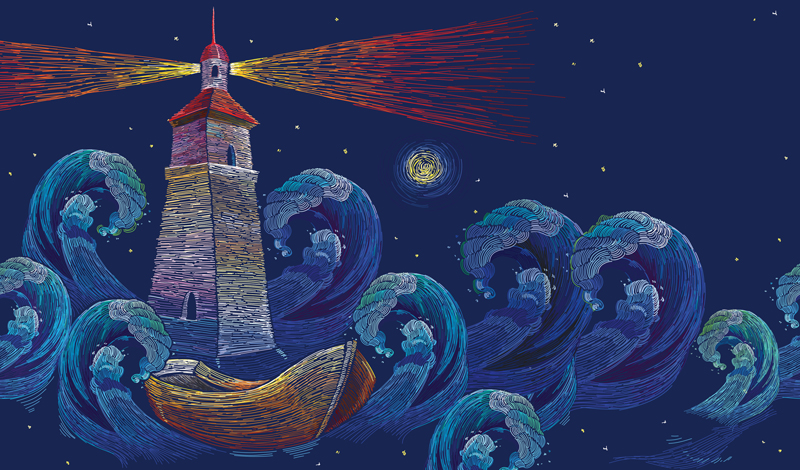In the mid-15th century, Cape Bojador remained the southernmost point that Portuguese explorers were willing to voyage. What lay beyond the cape was the province of superstition: boiling waters, sea monsters, the end of the earth. Such were the tales that seafarers coined the waters the Sea of Darkness, the point of no return.
Prince Henry, the fourth child of the Portuguese king, believed that finding a sea route to the East would open up vast possibilities for the country and, thus, spent his personal wealth training navigators. He urged them to cast aside superstitions and travel beyond the cape until one attendant, Gil Eannes, succeeded in 1434.
The country was still far from discovering a route to the east, to pioneering the Great Age of Discovery, yet his accomplishment represented an inflection point.
Ikeda Sensei, while in Portugal in October 1965, said of Eannes:
He had revealed that the much-feared Sea of Darkness beyond Cape Bojador was actually no different than the rest of the ocean, thus dispelling the dark cloud of superstition in people’s minds. Indeed, the Sea of Darkness existed only in the mind. With the rudder of courage, Eannes succeeded in sailing beyond his own personal “cape of fears.”[1]
We all have a “cape of fears,” so to speak, something that prevents us from confronting our most difficult challenges and accomplishing our dreams. Boldly sailing past it is the purpose of Buddhist practice. What’s more, it can be said that our effort to advance kosen-rufu, and create a more just and peaceful society, is a task reserved for the courageous. So, what holds us back? In this issue, we look at the Buddhist perspective on overcoming fear.
First, decide to win!
Throughout human evolution, fear has served a vital function, protecting people from legitimate threats to survival. Today we may not typically face daily life-or-death situations, yet some 60% of adults report having at least one unreasonable fear.[2]
In The Treatise on the Great Perfection of Wisdom, fear is described as the sixth of the “ten kinds of troops,” ten types of hindrances to Buddhist practice that sway us in varied and subtle ways. For that reason, surmounting our fears requires courageous faith aimed first at breaking through within.
In volume 3 of The New Human Revolution, Sensei explains how India’s struggle for independence began when the people first gained their spiritual independence. He writes:
Above all, Gandhi purged the fear so long ingrained in people’s hearts. When the people stopped being intimidated—when they stood up straight with dignity and pride—the arrogant authorities who tyrannized them would inevitably fall.
Jawaharlal Nehru, the first prime minister of an independent India, asserted that driving fear from people’s hearts had been Gandhi’s “greatest gift” to India.
What is fear? It is but an illusion created by one’s own mind. Cowards tremble with fear at shadows of their own making. “Do not fear!” Shakyamuni Buddha taught long ago. In our own age, Gandhi also called on the people of India to cast aside their fear. They responded by standing up with courage, marking the true dawn of India’s independence.[3]
When we decide to challenge our preconceived limitations, we set into motion the causes for victory.
‘Victory is guaranteed when we pray with all our might.’
There are times when we may wonder whether it’s possible to break through a specific challenge, but Nichiren Daishonin assures us that prayer based on a vow for kosen-rufu can even move the universe. He writes:
There is nowhere throughout the worlds of the ten directions that the sound of our voices chanting daimoku [Nam-myoho-renge-kyo] does not reach. Our voices may be small, but when we intone the powerful sound of daimoku, there is no place in the entire major world system that they do not penetrate.[4]
Speaking of this passage, Sensei explains that our prayers won’t be fulfilled if we just chant without any real focus or determination. What’s important is to strive to chant wholeheartedly and challenge ourselves more than anyone in faith, using courage and perseverance as our guides. He writes:
By praying before the Gohonzon, we activate the benevolent deities—the protective functions of the universe. From the perspective of Buddhism, the law of cause and effect ensures that the moment we pray, we create a cause for our victory, for our prayers to be answered.
But this is not perceptible to us as ordinary people, and as a result we may have doubts and worries about whether our prayers will in fact be answered. Prayer is an ongoing battle against fundamental ignorance, the ultimate form of delusion. Faith means having complete conviction in the indisputable law of life, even though we may not be able to perceive it directly. By chanting Nam-myoho-renge-kyo, employing the “strategy of the Lotus Sutra,”[5] we can conquer fundamental ignorance.
If we forget about prayer and only pursue strategies or methods, we are very likely to find ourselves going in circles. Supreme victory is guaranteed when we pray with all our might as practitioners of the Lotus Sutra.[6]
Spreading the Mystic Law is the quickest way to overcome our limitations.
Mahayana Buddhism sets forth the ideal of the bodhisattva who seeks enlightenment for both self and others, even postponing one’s own enlightenment to lead others to that goal. Shakyamuni describes these bodhisattvas as “firm in will, in no way timid or immature. For immeasurable kalpas they have been practicing the bodhisattva way. They are clever at difficult questions and answers, their minds know no fear.[7]
When we engage in this essential practice for “self and others” by sharing Buddhism with those around us, we chip away at our lesser self, concerned with only our own salvation, and foster a fearless and compassionate spirit.
The more we engage in this bodhisattva practice of supreme respect for others, the more our lives come to shine with happiness and dignity. Sensei says of this process:
[Sharing Buddhism] is … a struggle to break down the icy walls of darkness or ignorance in our own lives, which take the form of apathy, passivity and other negative emotions.
When we talk with others about Buddhism, we are actually grappling with our own ignorance and earthly desires. That’s why it gives us the strength to surmount our own problems, enabling us to solidly transform our state of life and change our karma.
In that sense, sharing Buddhism comes down to overcoming our own cowardice, laziness and delusion, thus enabling us to dispel the darkness or ignorance in our own lives and in the lives of others.[8]
As Bodhisattvas of the Earth, sharing the Mystic Law represents the ultimate form of courage. Sensei explains:
“Fearlessness” means to expound the Law bravely and without fear. It indicates the Buddha’s unshakable self-confidence in expounding the Law.[9]
Speaking to others about our ideals can be difficult. We not only make ourselves vulnerable to having our deeply cherished beliefs challenged by others but we have no way to predict how people will respond.
Regardless of the reaction, that person before us will benefit greatly from hearing the name of the Mystic Law, and we, in turn, will have strengthened our own confidence in our Buddha nature.
Planting seeds of the Mystic Law, sharing Buddhism with others, enables us to become bodhisattvas whose “minds know no fear.”
United with a great mentor, we become courageous lions.
When we think of our own “cape of fears,” it becomes all the more important to not only develop a fearless spirit but to sustain it, given life’s stormy seas. In volume 6 of The New Human Revolution, Shin’ichi Yamamoto (Ikeda Sensei’s character in the novel) shares the source of his fearlessness as he journeys throughout the world to make the humanistic principles of Buddhism accessible to all:
Whenever Shin’ichi thought of his mentor, he felt tremendous courage and energy well up within him, and he knew he could withstand any hardship. No matter how determined we are to live according to the highest ideals, it is easy to be defeated by the fear or doubt, complacence or arrogance arising in our minds. That is why the Daishonin admonishes us, “Become the master of your mind rather than let your mind master you” (“Reply to the Lay Priest Soya,” WND-1, 486). As long as we are able to keep the example of our mentor alive in our hearts, we can triumph over our personal weaknesses.[10]
When we unite in spirit with the mentors of Soka, sharing the same goal to advance kosen-rufu for the happiness of humanity, we foster a fearless self that can remain undefeated by life’s crushing blows.
In a February 2018 message, Sensei called on the SGI-USA youth to forge on as one, with the same invincible spirit of the lion king:
Lions never succumb nor do they ever retreat. Lions leap ahead, roar, battle and win without fail.[11]
When we decide to win, chant courageous daimoku based on a vow and teach the Mystic Law to others, firmly rooted in the shared vow of mentor and disciple, we not only become fearless explorers of life but also light a bright path for all other navigators to come.
—Prepared by the Living Buddhism staff
References
- The New Human Revolution, vol. 10, p. 221. ↩︎
- https://www.psychologytoday.com/us/basics/fear <accessed on October 24, 2022>. ↩︎
- NHR-3, 96. ↩︎
- Gosho zenshu, p. 808. ↩︎
- “The Strategy of the Lotus Sutra,” The Writings of Nichiren Daishonin, vol. 1, p. 1001. ↩︎
- November 2021 Living Buddhism, pp. 62–63. ↩︎
- The Lotus Sutra and Its Opening and Closing Sutras, p. 263. ↩︎
- June 2019 Living Buddhism, p. 53. ↩︎
- The Heart of the Lotus Sutra, p. 85. ↩︎
- NHR-16, 6. ↩︎
- May 2018 Living Buddhism, p. 17. ↩︎
You are reading {{ meterCount }} of {{ meterMax }} free premium articles





